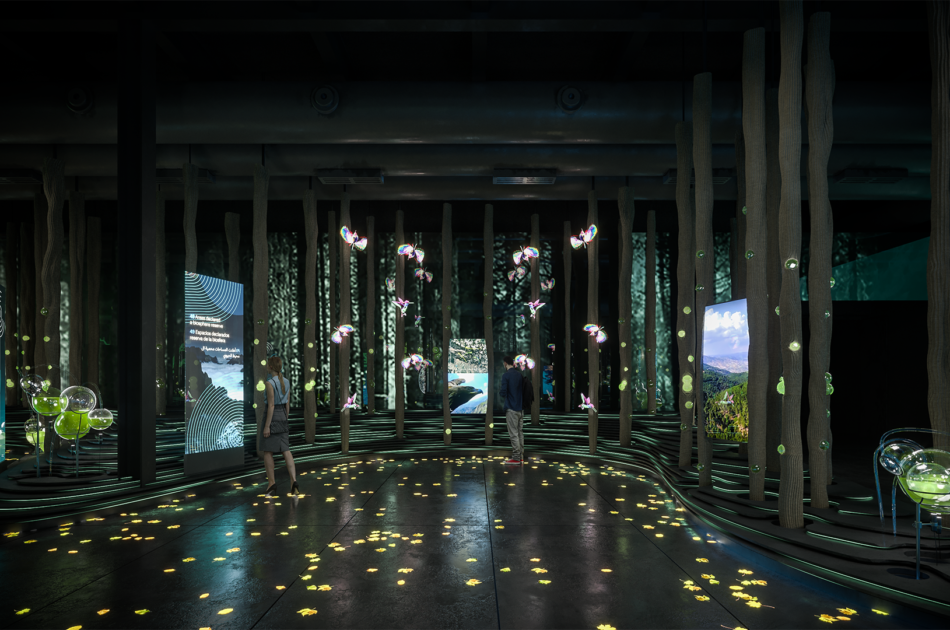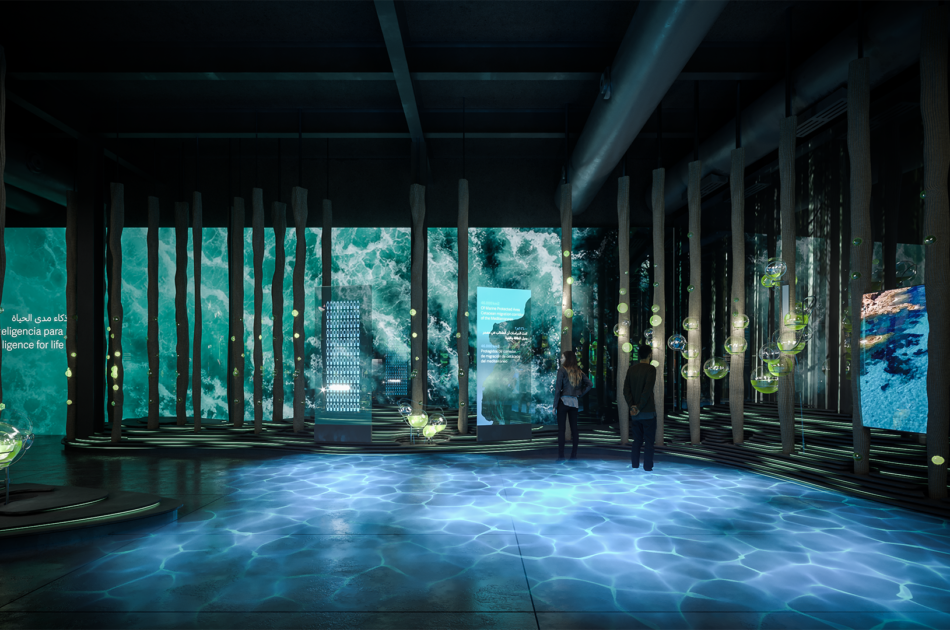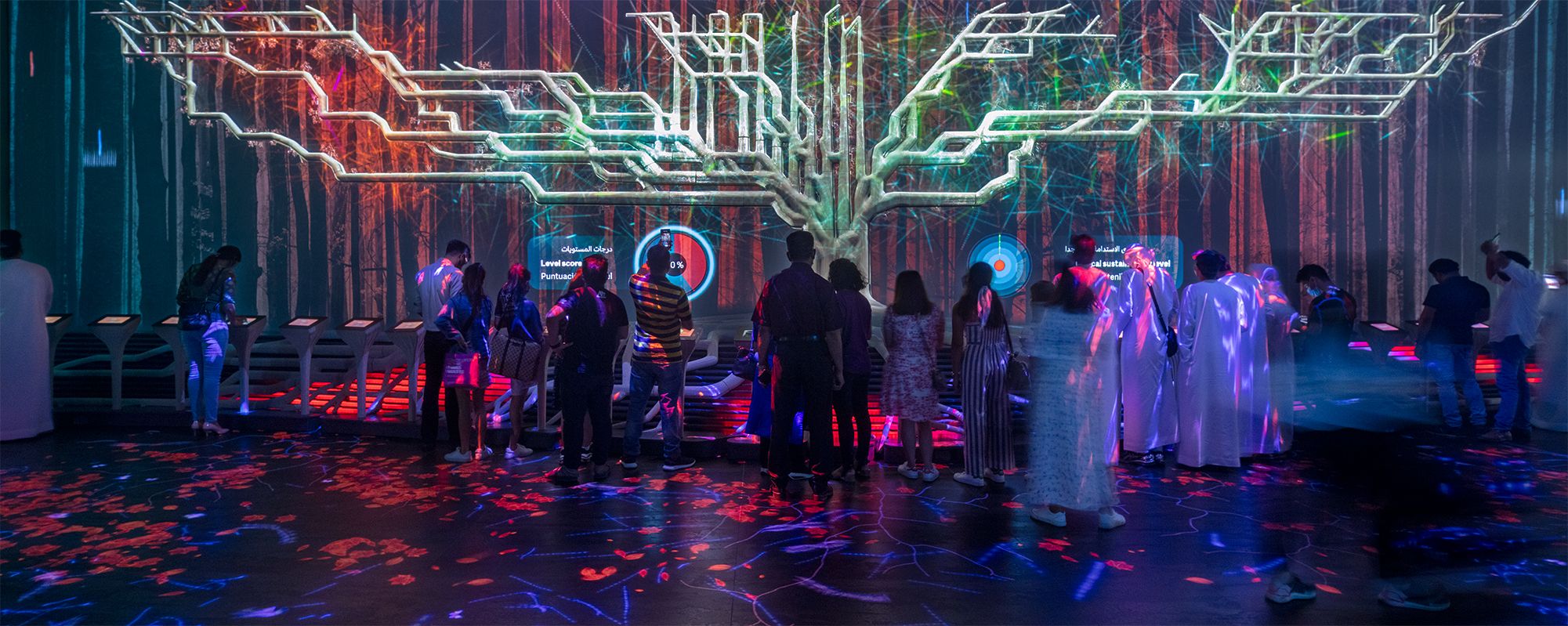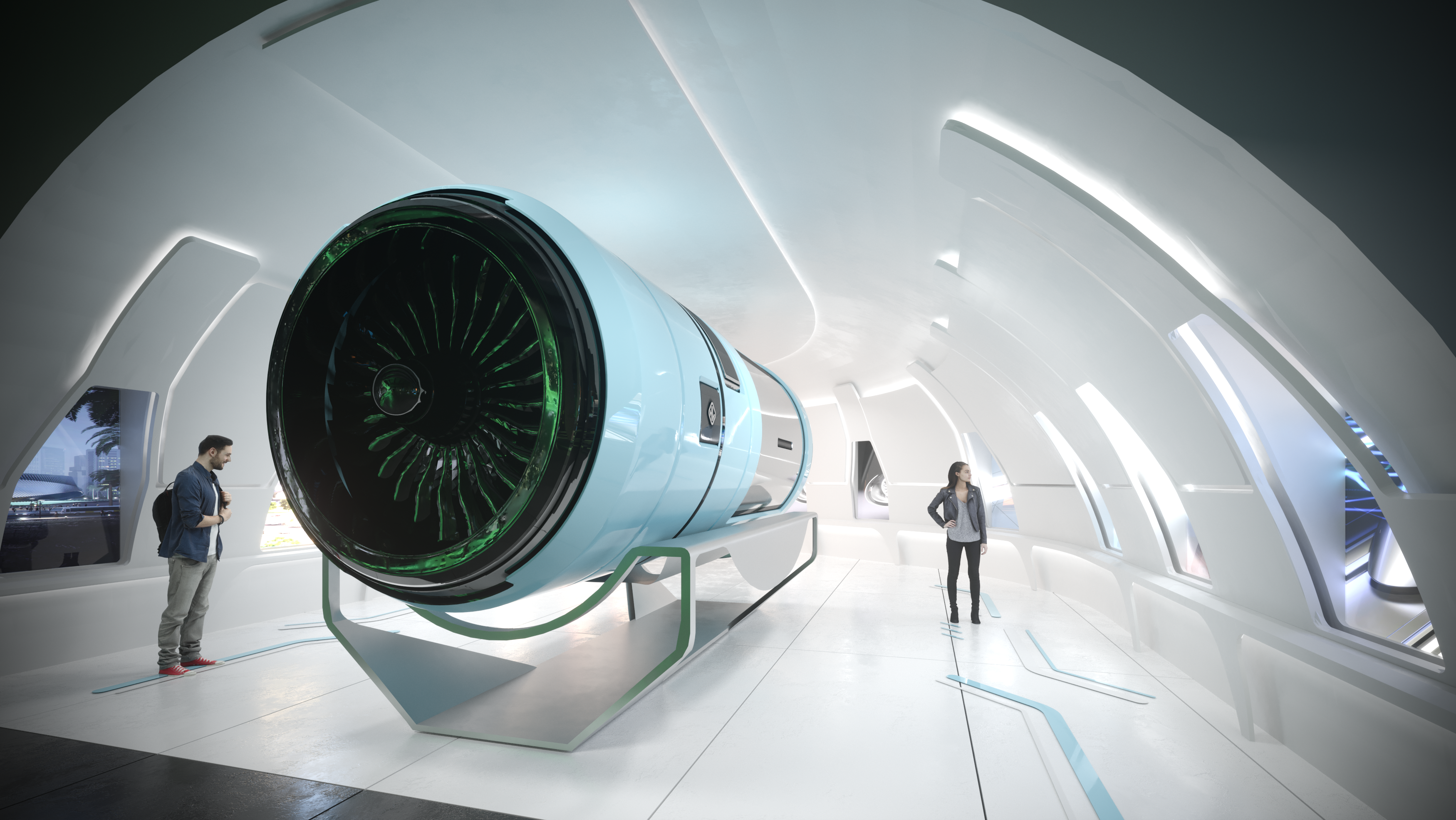During the next six months, visitors at Expo Dubai 2020 can step into a 3D printed artificial forest at the Spain pavilion. Conceived by Barcelona-based studios Onionlab and External Reference, the project, dubbed Forest of Intelligence, immerses visitors in a world of biodegradable and recyclable organic materials, interactive floors, and 3D printed trees. Aside from its aesthetic beauty, the exhibition gallery showcases Spain’s efforts to uphold the United Nations’ 2030 Agenda for Sustainable Development.
Made up of trees created with a special material that can absorb carbon dioxide (CO2) in real-time to produce oxygen, the Forest of Intelligence represents the country’s contributions to the protection and sustainable use of natural resources. Attendees can visit the interactive floors, become immersed in augmented reality, and meet a “living” tree called the Tree of Balance.

The Forest of Intelligence at the Spanish Pavillion in Expo Dubai 2020 is an immersive experience. Image courtesy of Onionlab.
Once visitors enter the interactive exhibition, they will encounter a lively and educational experience designed by Onionlab’s Aleix Fernández and External Reference’s Carmelo Zappulla. For this project, the duo chose to work at the intersection of art, design, and technology to help visitors discover ground-breaking and pioneering Spanish initiatives, sustainable projects, and local startups. For the task, they used animated graphics, infographics, holograms, mappings on 3D models, large-format audiovisual pieces, and interactive installations. Even the forest is built with biodegradable and recyclable organic materials and photobioreactors with microalgae. The result is an immersive installation and one of the most prominent spaces in the multifaceted Spanish exhibit.

The Forest of Intelligence at the Spain Pavillion in Expo Dubai 2020 has 3D printed trees that absorb CO2 and turn it into oxygen. Image courtesy of Adrià Goula/Labóh.
The artificial 3D printed forest “immerses visitors in an extraordinary world where digital and physical dimensions produce unique experiences,” External Reference describes. The trees are built with a sustainable bioplastic polymer made with corn dextrose (sugar), mixed with PURE.TECH, a natural mineral compound that is able to capture and mineralize some of the main greenhouse gases and pollutants in our planet’s atmosphere, including CO2, nitrogen oxides (NOx), and volatile organic compounds (VOC). PURE.TECH is an original creation of research platform Reshape and Spanish biotechnology firm PrimLab to address the problem of environmental pollution. The material is being widely adopted in manufacturing processes of many industries where 3D printing is thriving, including fashion technology, interior design, and construction.
Through the use of such innovative technologies and materials, this sustainable landscape is capable of producing oxygen and food through photosynthesis thanks to a series of photo-bioreactors containing microalgae, such as spirulina and chlorella, that have been designed exclusively for the pavilion, says Zappulla. Invisible to the naked eye, the microscopic algae can increase oxygen levels, reduce global warming, and eventually prevent the future consequences of climate change.

The Forest of Intelligence at the Spanish Pavillion in Expo Dubai 2020 is an immersive experience. Image courtesy of Onionlab.
As for the 3D manufacturing of the trees, the design architects turned to La Máquina by Noumena, a state-of-the-art manufacturing center scaling up novel solutions for the 3D printing industry. La Máquina frequently prints with PURE.TECH material technology for its projects, and is a wide adopter of Italian 3D printer manufacturer WASP’s large scale platforms. In fact, the two companies are technical partners, and for this project, La Máquina leveraged WASP’s Delta 3D printers to create the air pollution-absorbing trees for the pavilion.
External Reference has been experimenting with branching, artificially living, 3D printed organisms that engage viewers to interact with a sustainable ecosystem. For example, in 2020, the design studio 3D printed a Christmas tree with PrimLab’s sustainable material technology and WASP’s additive construction systems. Similarly, for the Shenzhen Science Museum in China, the firm developed a 3D printed central installation that shows the interconnection between living and artificial elements in the world.

The Forest of Intelligence at the Spain Pavillion in Expo Dubai 2020 is packed. Image courtesy of Adrià Goula/Labóh.
However, the intelligent forest is unlike any other exhibit. It invites viewers to reflect on the adoption of sustainable habits to guarantee that future generations will survive on this planet. The message is as powerful as the overwhelming space that traces three thematic areas: biodiversity preservation, balanced use of resources, and collective intelligence.
Inside the “forest,” visitors can interact with digital infrastructures and witness how, for example, the pavilion itself monitors consumption to be more efficient. The exhibit even has some incredible features on display, like a six-meter-long hyperloop vehicle developed by Zeleros, a thriving startup born from a team of students at the Polytechnic University of Valencia (UPV). Other prominent spaces in the exhibit are interactive floors that will react to the movements of visitors and huge backlit murals in the background.

Zeleros’ hyperloop vehicle is on display at the Spanish Pavillion in Expo Dubai 2020. Image courtesy of Spain Pavillion.
However, the central piece is the immersive Tree of Balance installation. Described as the “heart of the tour,” it is a 3D printed structure that occupies the entire back wall of the exhibition and is the final section for visitors. Its roots are spread across the edges of the physical space to generate topographies inhabited by other 3D printed trees. The roots also become screens that visitors can interact with to answer questions about their own sustainable habits. If visitors prove that they support sustainability, then the tree will flourish. Otherwise, the leaves will wither.
Have you stepped into the Forest of Intelligence at the Spain Pavilion yet? If not, Expo Dubai 2020 will be open to the public through March 31, 2022.
Subscribe to Our Email Newsletter
Stay up-to-date on all the latest news from the 3D printing industry and receive information and offers from third party vendors.
You May Also Like
3D Printing News Briefs, April 13, 2024: Robotics, Orthotics, & Hypersonics
In 3D Printing News Briefs today, we’re focusing first on robotics, as Carnegie Mellon University’s new Robotics Innovation Center will house several community outreach programs, and Ugogo3D is now working...
Rail Giant Alstom Saves $15M with 3D Printing Automation Software 3D Spark
3D Spark has entered into a three-year deal with the rail giant Alstom. Alstom, a transport behemoth with annual revenues of $16 billion, specializes in the manufacture of trains, trams,...
Meltio Expands Global Reach with New Partnerships in the Americas and Europe
Spanish 3D printing manufacturer Meltio has expanded its sales network across the globe. With the addition of three new partners in the United States, Brazil, Argentina, and Italy, Meltio aims...
3D Printing Webinar and Event Roundup: April 7, 2024
Webinars and events in the 3D printing industry are picking back up this week! Sea-Air-Space is coming to Maryland, and SAE International is sponsoring a 3D Systems webinar about 3D...































